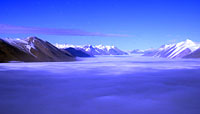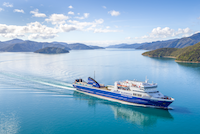 Antarctica Regional Information
Antarctica Regional Information
Antarctica | Regional Information | Activity Highlights | Scenic Highlights | History
Antarctica is a continent of extremes. The coldest, windiest, highest and driest continent on Earth, it lies over the south pole covering an area of 14.4 million square kilometres.
Antarctica Overview

Antarctica is located over the south pole of the Earth, mostly south of the Antarctic Circle and completely surrounded by the Southern Ocean
Although Antarctica is often perceived as a barren continent the area is home to a wide range of cold-adapted animal and plant life.
There has never been an indigenous population in Antarctica. Some governments maintain permenent research stations across the continent, though there are no permanent residents on the continent. This research population varies from about 4,000 people in the summer season to about 1,000 over winter.
Antarctica Highlights
Cape Denison, located in Commonwealth Bay, is part of the Australian Antarctic Territory. The Cape is of particular historical significance as it is the site at which Sir Douglas Mawson's Australian Antarctic Expedition established its base, in 1911. The huts established by Mawson's expedition still stand there today, preserved by the AAP Mawson's Huts Foundation.
Cape Denison is notorious for its exceptionally windy conditions caused by the Antarctic cabatic winds and has become known as the "Home of the Blizzard".
Cape Hallet and Cape Adare lie at the tip of the Victoria Land region, set against the awesome vista of Antarctica's highest mountain range.

Dry Valleys, Antarctica
Photographer: Brien Barnett
U.S. National Science Foundation
Cape Hallet boasts some of the most magnificent scenery in the region. Sunlight reflects off the mountainous, ice covered terrain onto surrounding icebergs, while the perfectly still waters act as a mirror to further enhance this breath-taking scene. Nothing remains from the base which was once here, the site now home to the Adelie penguins.
Cape Adare's black pebble-covered beach is home to one of the largest Adelie penguin colonies in the Ross Sea area. During the Adelie's breeding season about a quarter of a million nesting pairs inhabit the beach, travelling between here and their rookery in massive waves to best avoid predators.
The cape is also the site of the first permanent Antarctic structure. The Borchgrevink Expedition hut has been restored thanks to on-going conservation work and now stands as a memorial on the vast beach.
The Ross Ice Shelf is the largest in Antarctica and the largest body of floating ice in the world. At times this natural ice barrier can create hazardous conditions with gale force winds blowing sheets of snow across the landscape.
Ross Island is situated at the base of the Ross Sea, its main geographical feature—Mount Erebus—is a 13,000 foot high volcano.

Photographer: Heritage Expeditions
(www.heritage-expeditions.com)
Cape Bird, on Ross Island, is the site of the New Zealand Antarctica programme's field station from which scientists study the natural history of the region, particularly the large Adelie penguin colony. At Cape Royds lies the hut of Sir Ernest Shackleton, built during the Nimrod polar attempt from 1907 to 1909.
At the foot of Ross Island, in McMurdo Sound, is McMurdo Station—the United States Antarctic Base. The largest research centre in Antarctica, McMurdo is also home to New Zealand's Scott Base and Scott's original Discovery Expedition hut.
Antarctica Main Centres
- McMurdo Sound - Site of Scott Base and McMurdo Station
- Amundsen-Scott Station - Located at the geographic south pole
- Mawson Station - Australia's Antarctic station
- Halley Station - The United Kindom's Antarctic station
Antarctica Region Information
 Regional Information
Regional Information
Key information and facts about the Antarctica region.
 Activity Highlights
Activity Highlights
Major activities and attractions in the Antarctica region.
 Scenic Highlights
Scenic Highlights
Major natural attractions in the Antarctica region.
 History
History
History of the Antarctica region.

















